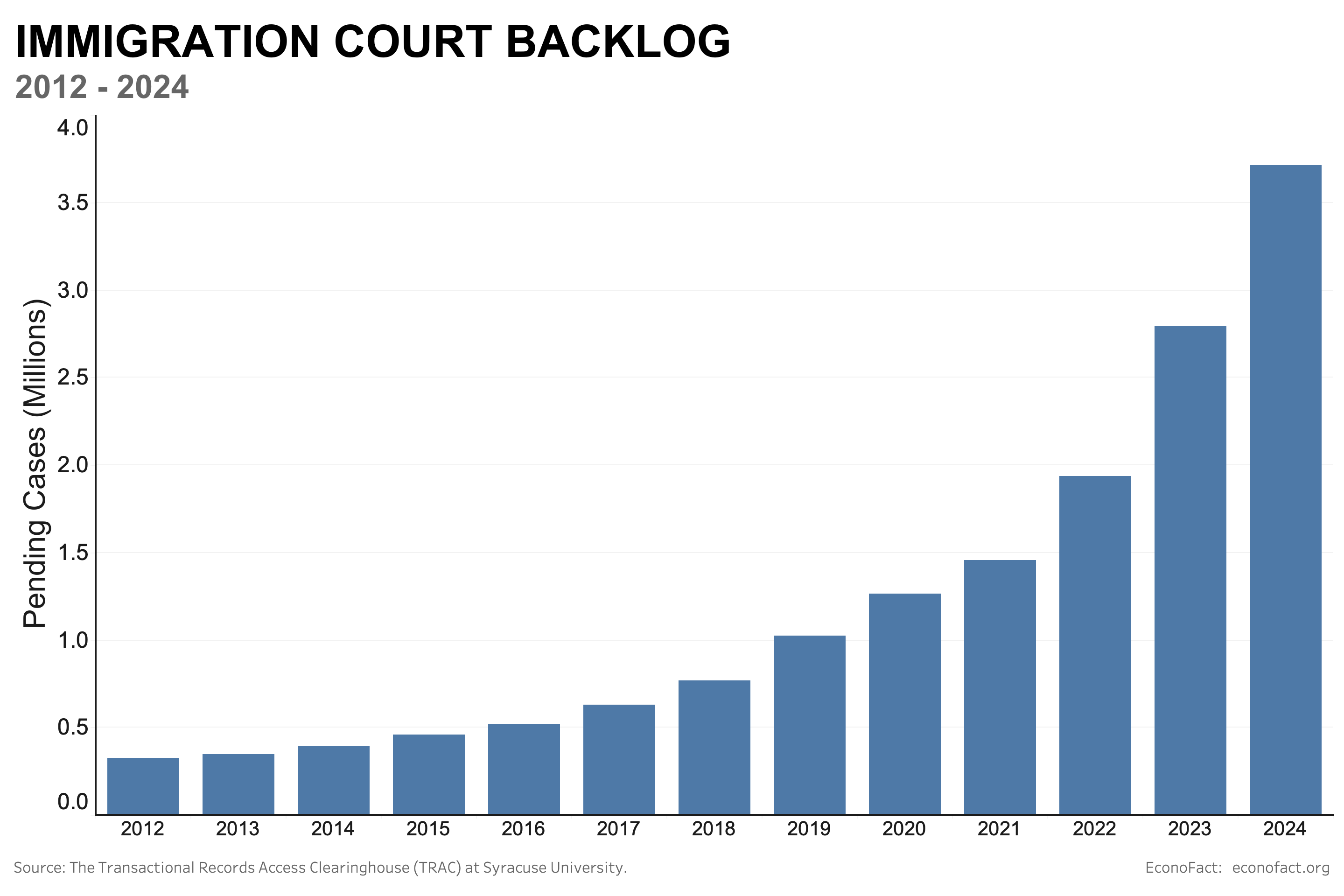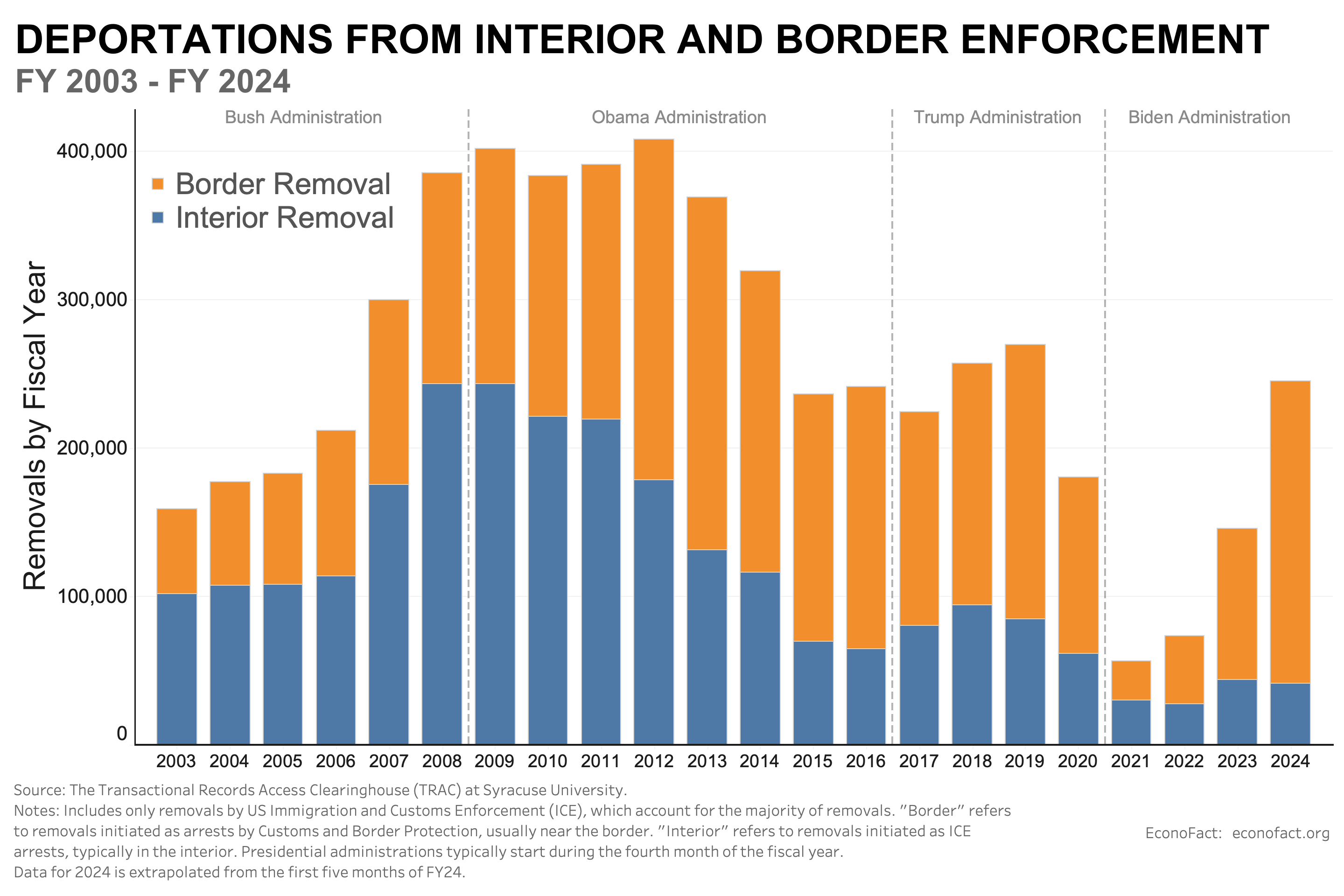Immigrant Deportations: Trends and Impacts
Brookings Institution
Click here for a larger version of this graph.
The Issue:
Deportations have long been a part of immigration enforcement and their number has fluctuated significantly in the last few decades. Former President Trump has promised to take this further and significantly ramp up the policy with a mass deportation of people who do not have the legal authority to be in the country. Recent research on previous episodes of increased immigration enforcement shed light on the impact deportations can have on labor markets, crime, and broader civic life. What is the current trend in immigrant deportations? What are the obstacles and implications of significantly expanding current practice?
The resource and logistical challenges of mass deportation are substantial. But even modest changes to deportation policy could have significant impacts.
The Facts:
- Who can be deported from the United States? Deportation is the process of removing a foreign national from the United States for violating immigration law. Non-citizens may be deported if they participate in criminal acts, if they are considered a threat, or do not have a valid visa status (see here). There were an estimated 11-12 million undocumented residents living in the United States as of 2022, a number that stayed fairly stable over the prior decade. That figure may have increased since 2022, however, with more entries without inspection across the border and significant numbers overstaying temporary visas.
- What about the immigration surge? The last two years have seen a high and unprecedented influx of an estimated 4 million people who are seeking asylum in the U.S. or coming to the U.S. on a temporary humanitarian parole program for countries in crisis. These foreign nationals are in a twilight status — not currently in violation of immigration laws, but it is expected that many will lose their petition for asylum or face an expired parole in the next year or two. Many of the new arrivals will not have the legal right to stay in the United States within a year or two and be at risk of removal.
- The highest number of annual immigrant deportations in recent years occurred during the first years of the Obama Administration reaching about 400,000 per year. But aggregate deportation statistics can be somewhat misleading because they include both actions against those living in the United States for many years and individuals turned back at the border — which have very different economic and social implications. Border enforcement statistics are partly a reflection of changes in migratory flows, which can be driven by events outside of the United States. Interior enforcement typically impacts those who live and work in the United States, having distinct effects on local businesses, families, and communities (see here).
- Removals processed by Immigration and Customs Enforcement (ICE) make up the bulk of deportations and include both those stemming from the border and interior. To get a clearer picture it is helpful to separate enforcement actions initiating with Customs and Border Patrol (CBP) — which typically refer to actions aimed at stemming entry — from those initiating with Immigration and Customs Enforcement (ICE), which are more likely to involve the population of roughly 11 million undocumented immigrants who live in the United States (see chart). Interior removals were particularly high during President Obama’s first term, averaging over 200,000 per year. The Trump administration removed an average of 80,000 people from the country ‘s interior annually, many fewer than Obama and a small fraction of what the campaign rhetoric of mass deportation might imply. The Biden administration has removed even fewer people from the country’s interior.
- Deportations, even on a comparatively modest scale, also have direct economic consequences as workers are removed. Immigrants are critical to the US labor force, and disruptions create ripple effects in the economy. Economists have studied the labor market impact of increased immigration enforcement during the rollout of Secure Communities, a program that increased information sharing between local law enforcement and immigration authorities and resulted in over 400,000 people being deported between 2008-2014. One study finds that the deportation of 500,000 immigrants not only reduces the employment of foreign workers but also reduces the employment of an estimated 44,000 US-born people. A reason for this is that immigrants are often employed in jobs that complement rather than compete with US-born workers. For instance, a 2024 study found that the implementation of Secure Communities reduced the supply of foreign-born construction workers and led construction companies to hire fewer US-born construction site managers and other higher-skilled workers. Moreover, immigrants are also a source of demand for domestic goods and services. As their population declines, local businesses see a decrease in revenues and have to cut back their expenditures.
- While addressing crime is often cited as one reason for increasing immigration enforcement, there is no evidence that increasing deportations leads to a reduction in crime. Contrary to some public rhetoric, a substantial literature suggests that immigrants have lower crime rates than the U.S.-born population. Nevertheless, deportations focused on those convicted of crimes could theoretically reduce crime. A study of the impact of Secure Communities, which did target immigrants involved with law enforcement, failed to find empirical evidence to support that immigrant deportations reduced property or violent crime. A greater focus on deportation could make immigrants less likely to cooperate with authorities and less likely to report certain kinds of crime (see here). While total crime rates remained unchanged in the wake of Secure Communities, a recent study found that the program reduced the likelihood that Hispanic victims reported crimes to police and increased the victimization of Hispanics.
- Impacts of increased immigration enforcement can extend beyond the direct effects on the immigrants deported and their immediate families. Enforcement generates broader “chilling effects” on immigrant decision-making in a variety of contexts including participation in the formal labor market, school attendance and health care access. For instance, although only people who were arrested had their immigration status checked under Secure Communities, even people not targeted for deportation became fearful of leaving their house to do routine things like going to work. One study found that Secure Communities reduced safety net participation among citizen families eligible to participate in safety net programs.

Click here for a larger version of this graph.
- The resource and logistical challenges of mass deportation are substantial. Spending on ICE has nearly tripled in the past two decades, with the current annual budget for ICE around $10B. Spending on the immigration court system, which is in charge of adjudicating removal and asylum claims, has not kept pace contributing to a backlog of over 3 million cases and years of delays in the immigration court system.
What this Means:
The idea of mass deportation is politically popular among about half of Americans, but the reality would likely change the character of civic life for Americans beyond what is currently realized. Today, a majority of interior deportations arise because an undocumented immigrant has a criminal conviction. A much-expanded enforcement regime would likely require widespread arrests in worksites, schools, health care facilities and other public places. It would also require a significant increase in enforcement spending even as it is unclear that it would be possible to hire enough federal agents to conduct mass deportation. Although these obstacles make it less likely that a Trump administration would enact mass deportation to the scale suggested by rhetoric, even modest changes could have significant impacts.
Like what you’re reading? Subscribe to EconoFact Premium for exclusive additional content, and invitations to Q&A’s with leading economists.

